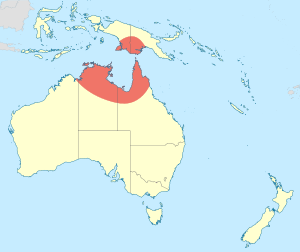Tiny longlegs facts for kids
Quick facts for kids Tiny longlegs |
|
|---|---|
| Conservation status | |
| Scientific classification | |
 |
The tiny longlegs (scientific name: Austrocnemis maccullochi) is a special type of damselfly. It's part of the Coenagrionidae family, which includes many small and delicate damselflies. This little insect gets its name because it's super small and has really long legs! It's mostly a shiny bronze-black color. You can find tiny longlegs living near calm water in coastal areas of northern Australia and New Guinea.
Contents
What is a Damselfly?
Damselflies are amazing insects that are closely related to dragonflies. They belong to an order of insects called Odonata. Both damselflies and dragonflies spend their early lives in water.
Damselflies are often smaller and more slender than dragonflies. When they rest, most damselflies hold their wings together over their back. Dragonflies, on the other hand, usually hold their wings out flat.
Where Tiny Longlegs Live
The tiny longlegs damselfly loves places with still water. This means you can find them near ponds, lakes, or slow-moving parts of rivers. They live in the warm, coastal areas of northern Australia. You can also find them on the island of New Guinea.
These areas provide the perfect home for them. They need water for their young to grow. They also need plants around the water for hunting and resting.
Appearance of the Tiny Longlegs
The tiny longlegs is, as its name suggests, a very small damselfly. It has a body that looks bronze-black. This dark color helps it blend in with its surroundings.
One of its most noticeable features is its very long legs. These long legs are useful for catching small insects. They also help it perch on plants near the water. Like all damselflies, it has two pairs of wings. These wings are clear and have a network of tiny veins.
Life Cycle of a Damselfly
Damselflies, including the tiny longlegs, have a fascinating life cycle. It starts with an egg and goes through different stages.
Eggs and Nymphs
Female damselflies lay their eggs in or near water. They often place them on underwater plants. Once the eggs hatch, tiny creatures called nymphs (or larvae) emerge.
These nymphs live underwater. They breathe using special gills. Nymphs are predators, meaning they hunt other small water creatures. They grow by shedding their skin many times. This process is called molting.
Emergence and Adults
When a nymph is ready, it crawls out of the water. It usually climbs onto a plant stem or a rock. Then, its skin splits open, and the adult damselfly emerges. This is a truly amazing sight!
The adult damselfly has wings and can fly. Its main job is to find a mate and lay eggs. Adult damselflies are also predators. They catch small flying insects like mosquitoes and gnats. They use their long legs to grab their prey in the air.
Why Damselflies are Important
Damselflies like the tiny longlegs are important parts of their ecosystem. They help control populations of insects like mosquitoes. This is good for humans and other animals.
They also show us how healthy a water environment is. If you see many damselflies, it often means the water is clean. Protecting their homes helps keep our planet healthy.
Gallery




